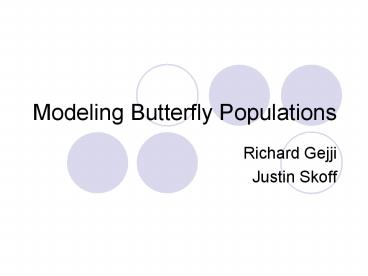Modeling Butterfly Populations
1 / 30
Title: Modeling Butterfly Populations
1
Modeling Butterfly Populations
- Richard Gejji
- Justin Skoff
2
Overview
- Introduction
- Beginning Assumptions
- Model Derivation
- Results
- Critique of Results and Assumptions
- Conclusion
3
- Introduction
- Beginning Assumptions
- Model Derivation
- Results
- Critique of Results and Assumptions
- Conclusion
4
Introduction
- Model looks at effects of weather on populations
- Specifically- body temperature
5
- Introduction
- Beginning Assumptions
- Model Derivation
- Results
- Critique of Results and Assumptions
- Conclusion
6
Beginning Assumptions
- Ignore mating/males
- All butterflies are female and are always
fertilized - All adults die at the end of a season, leaving
the eggs to hatch next season - No predators
- The change in number of flying and grounded
adults with respect to time is zero
7
Beginning Assumptions, Continued
- Reproduction is reliant upon flight
- The probability of egg laying while flying is
100 - The probability of flight is based on
- Body Temperature
- Genotype
- Time (sometimes)
8
- Introduction
- Beginning Assumptions
- Model Derivation
- Results
- Critique of Results and Assumptions
- Conclusion
9
Model Derivation
- A butterflys body temperature (BT) and PGI type
(?) affect its chances of flying
10
Model Derivation
- There are 3 PGI genotypes
- Stability is defined how flight probabilities
react to temperatures - Lower stability - probabilities affected more by
overheating - Due to PGI denaturing
- Efficiency
11
Model Derivation
- Equations that model overheating effects
- ? is the critical temperature
12
Model Derivation
- Variables
13
Model Derivation
- The change in x, f, and r over a time step ?t are
represented by the following equations
Need to find this
14
Model Derivation
- Use genotype ratios and Mendelian genetics to
find P(j produces i)
15
Model Derivation
- Skipping a bunch of steps (in the interest of
time) we get the final equation for number of
eggs
16
Model derivation
- Dealing with seasons
- Use x(t length of season) to find the number of
eggs laid - Assume 5 survive to make it to next season
- Use the number of these new adults as the
population parameters for this second season.
I.e, the P(j - i) table is reclaculated.
17
- Introduction
- Beginning Assumptions
- Model Derivation
- Results
- Critique of Results and Assumptions
- Conclusion
18
Results
- First, here is the actual probability curves we
used
19
Results
- We use a ß 3 chosen arbitrarily, and ?1 38,
?2 45, and ?3 41 which were chosen to fulfill
the table definition of stability. We start with
an even initial population of 30 of each type. - For bt 31
20
Results
- Bt 32
21
Results
- Bt 37
- Most efficient fliers die off because they dont
want to land. So both not flying too much and
flying too much is a death sentence
22
Results
- Bt 39
- Overheating does not seem to have too much effect
because for these body temperature ranges, the
flight probability is still large
23
Results
- BT 40
- As the body temperature increases, the flight
probability decreases and efficient types can
once again be efficient. We also see overheating
take effect and show the near extinction of type
1, while type 2 and 3, which are more stable
thrive.
24
Results
- At the right body temperature type 3 alone can
support the species
25
- Introduction
- Beginning Assumptions
- Model Derivation
- Results
- Critique of Results and Assumptions
- Conclusion
26
Critique
- Many of our assumptions have little or zero
experimental evidence - Linear changes of flying and landing adults are
proportional to the probabilities of flight and
non flight - Fast flying mechanics
- Flying rate coefficient is equal to the landing
rate coefficient - Assumption of constant body temperature incorrect
27
Critique
- The result that too much flying will cause a type
to die off is flawed - In real life weather fluctuations would change
that
28
- Introduction
- Beginning Assumptions
- Model Derivation
- Results
- Critique of Results and Assumptions
- Conclusion
29
Conclusion
- The original impetus of this experiment was to
investigate whether or not it is possible for a
fit species to die out due to the decrease of the
unstable types from higher body temperatures. - According to this model, we can predict that the
size of the type 1 and type 2 populations are
enough to control whether or not type 3
increases or decreases, however, if the weather
is favorable, it is possible for type 3 to not
only survive, but to generate the existence of
the other types.
30
Conclusion
- Investigation needs to be done on how reasonable
the flight/landing assumptions are. If they are
accurate, investigate if it is possible that
butterflies can die out due to a high flight
probability - According to the model, fluctuations in the size
of type 1 and type 2 can determine growth or
decline of type 3. Also, it is possible for a
collection of heterogeneous genotypes to sustain
the population. - As far as global warming goes, the equation
predicts for a small range, the unstable genotype
will almost die out while the stable types
survive and sustain the dying genotype. However,
if we exceed this range, all the butterflies die.































